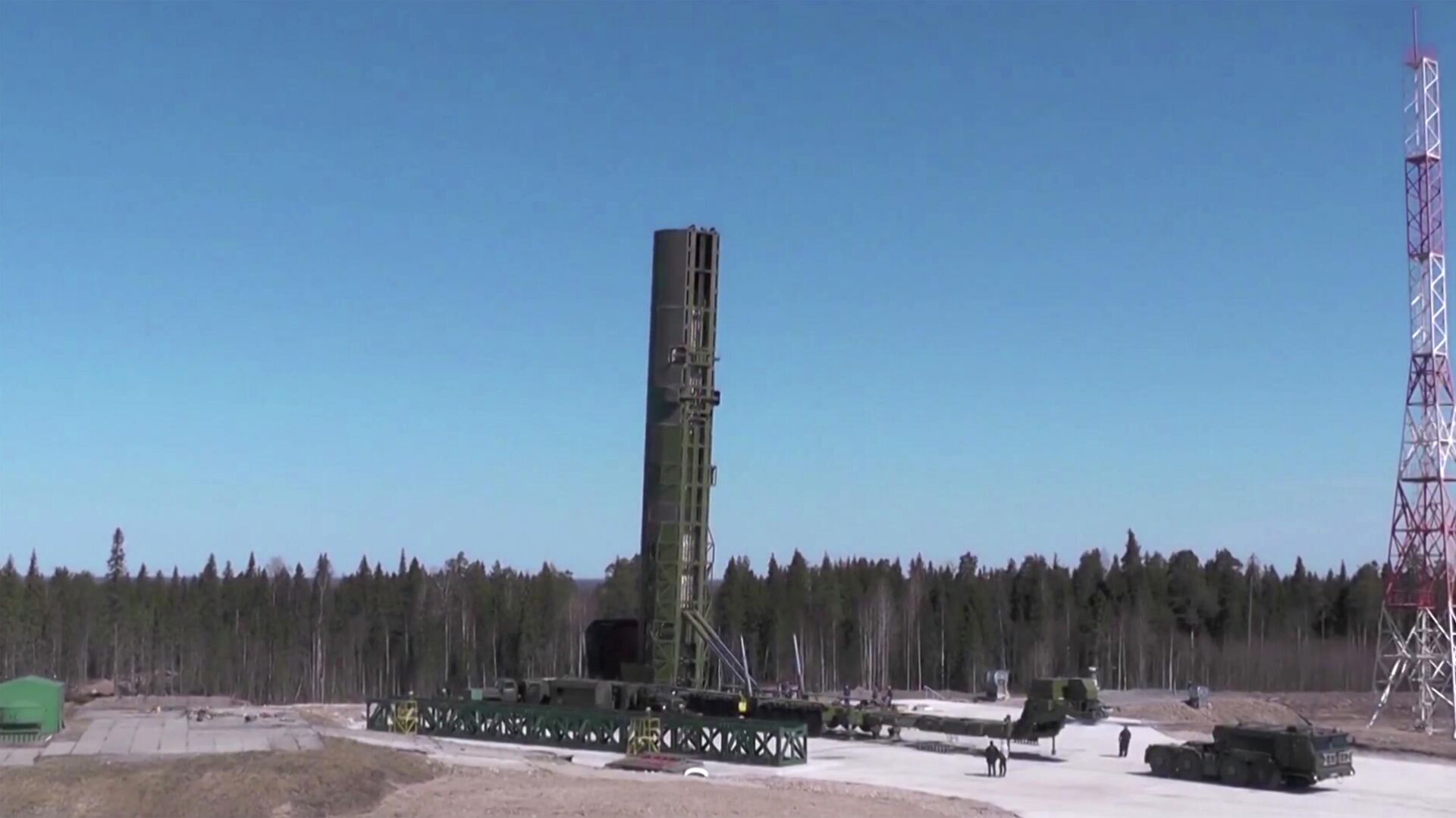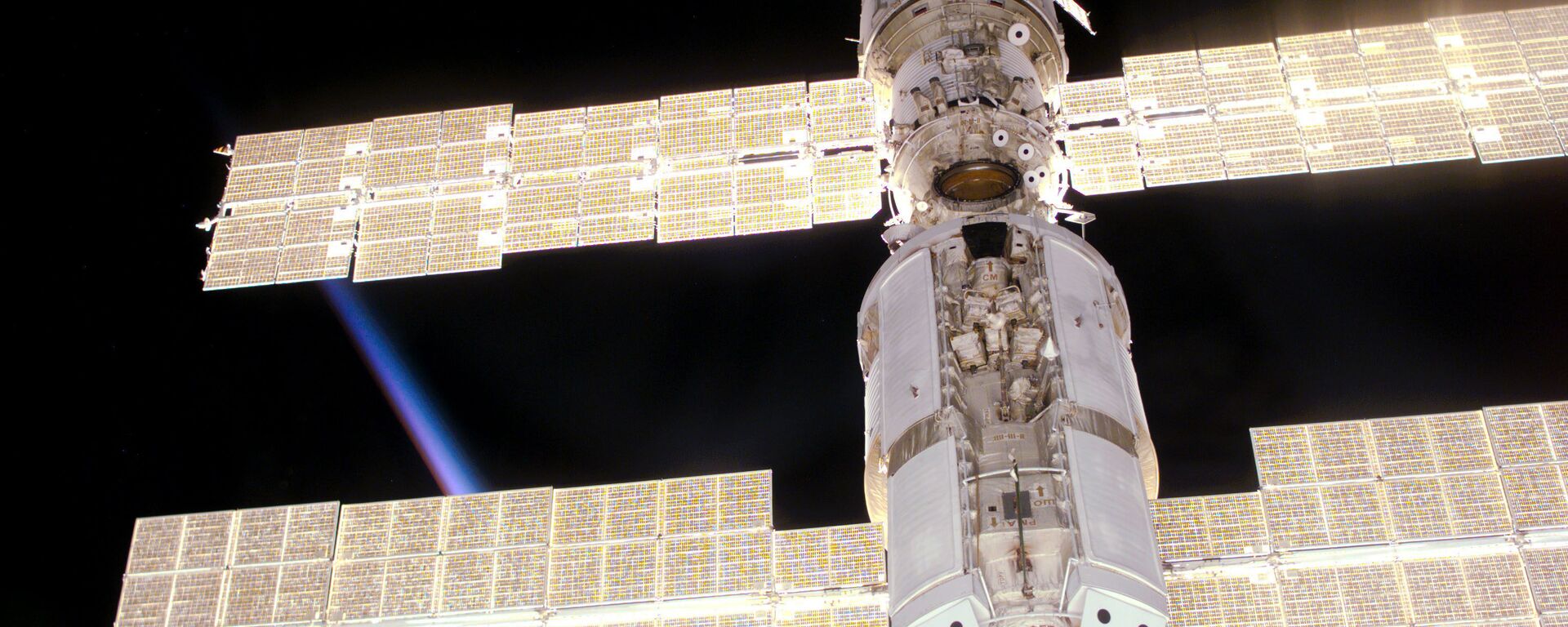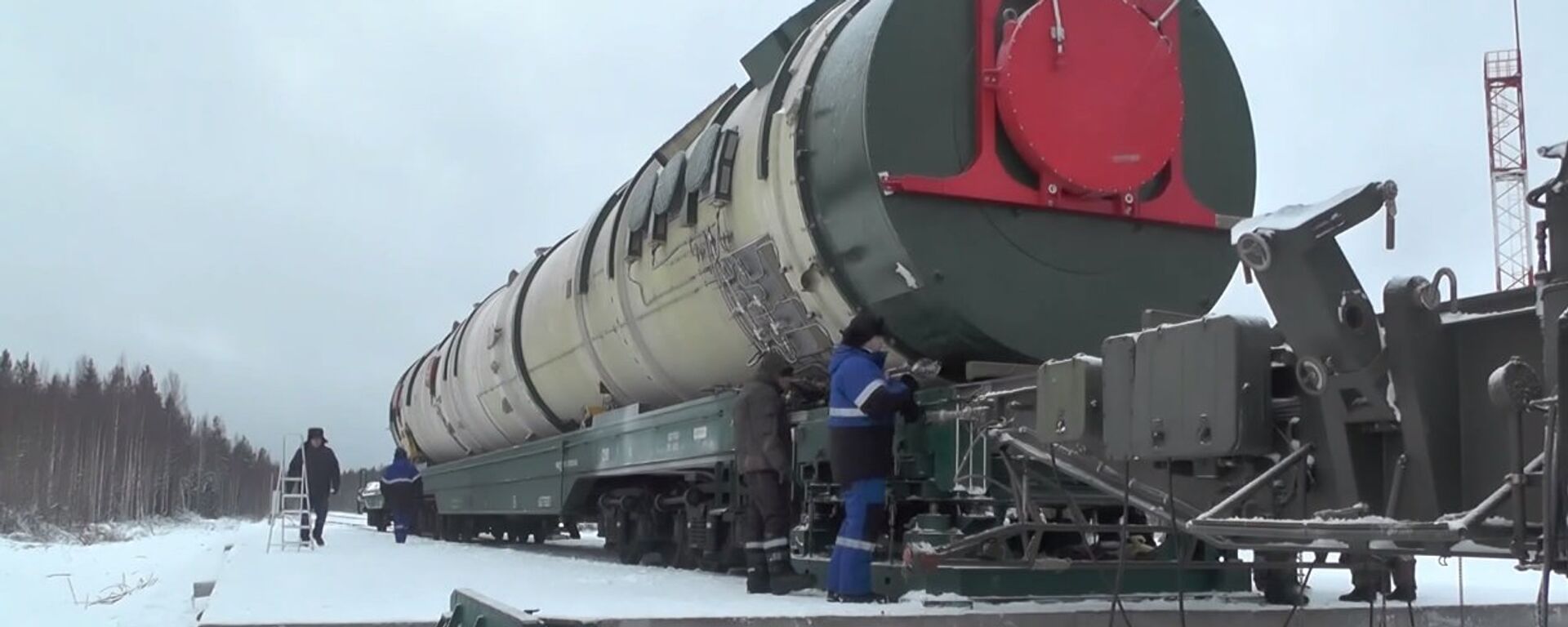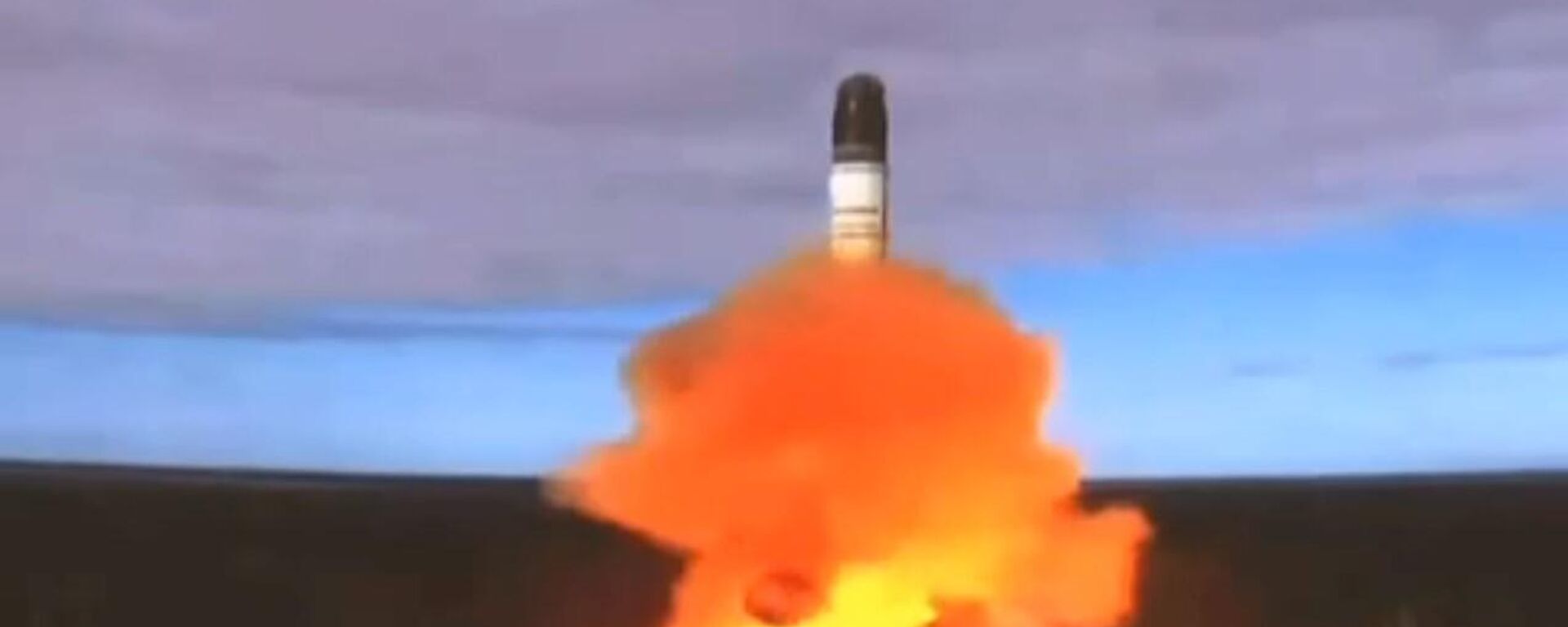https://sputnikglobe.com/20220922/russias-sarmat-icbm-can-correct-trajectory-even-if-hit-by-enemy-missile-defense-designer-says-1101087476.html
Russia’s Sarmat ICBM Can Correct Trajectory Even If Hit by Enemy Missile Defense, Designer Says
Russia’s Sarmat ICBM Can Correct Trajectory Even If Hit by Enemy Missile Defense, Designer Says
Sputnik International
The RS-28 Sarmat is Russia’s next-generation, nuclear-capable and multiple independent reentry vehicle (MIRV)-equipped super-heavy intercontinental ballistic... 22.09.2022, Sputnik International
2022-09-22T12:55+0000
2022-09-22T12:55+0000
2022-09-22T13:15+0000
military
sarmat
missile
missile defence
https://cdn1.img.sputnikglobe.com/img/07e6/04/14/1094923544_0:0:3641:2048_1920x0_80_0_0_5f2a4b7e7cc9d35343867437e25022c4.jpg
The Sarmat’s control system is designed to enable the missile to continue on its course even if it is struck by an anti-missile projectile, Vladimir Degtyar, chief designer at the Makeyev Rocket Design Bureau, the rocket center which developed the RS-28, has revealed.GLONASS is the Russian equivalent of the GPS, Galileo, and BeiDou satellite-based global navigation systems.With its 18,000 km range, the Sarmat can reach almost any point on the planet, Degtyar said.“Its quick acceleration to the required speed provides a high probability of defeating the enemy’s missile defense system during the active phase of the flight,” the academic said. “The Sarmat’s equipment includes several dozen different types of payload, which allows it to perform its tasks practically anywhere in the world,” he added.In addition, it is impossible for the adversary to precisely calculate the trajectory of the missile’s warheads, and difficult to detect them, as they are fitted with special equipment designed to conceal them in flight, both within Earth’s atmosphere and outside of it, Degtyar said.The chief designer, who has over 50 years of rocket design experience under his belt, expressed confidence that the Sarmat will “nullify all of NATO’s developments” with its “unsurpassed flight performance,” but also “the scientific and technical solutions used in its development and the modern technologies deployed in its creation.”Degtyar, whose background is in submarine-launched ballistic missile design, explained that during the Sarmat’s preliminary design and the follow-up design documentation stages, rocket scientists adopted the principles of naval missile design to their ground-launched analogue, whose weight and dimensions exceed those of naval missiles by five times.“This allowed us, firstly, to provide the missile with unique flight performance characteristics and, secondly, to reduce development time without losing the reliability of a number of rocket components and assemblies,” the chief designer explained.Degtyar also pointed to the Sarmat’s superiority over its predecessor – the R-36M2 Voyevoda (NATO reporting name "SS-18 Satan").The RS-36M2 has been in service with the Soviet and Russian strategic nuclear forces since the late 1980s.Degtyar expressed confidence that once the system is deployed, the Sarmat will become a reliable shield for Russia in the current difficult global geopolitical circumstances, the main factor in its nuclear deterrence and a reason to resume real negotiations on reducing global nuclear weapons arsenals.“The entire history of the ‘partnerly relations’ between us and our potential adversaries in all spheres: political, economic, and military, invariably shows that real negotiations which lead to a real, practical result begin only when parity is reached on the issue in hand, or Russia has the advantage,” the chief engineer stressed.The Sarmat is named after the Sarmatian people who populated the Eurasian Steppe in ancient times.In June, Russian President Vladimir Putin announced that Russia’s Strategic Rocket Forces would receive their first batch of the missiles by the end of 2022, with the defense sector tasked with building a total of 46 Sarmats. Each missile is designed to carry between 10-15 MIRVs, including nuclear warheads and missile defense countermeasures, as well as maneuverable Avangard hypersonic glide vehicle weapons.The first successful test launch of the missile was conducted in April.The Sarmat is one of half-a-dozen strategic weapons created by Russia’s military-industrial complex over the past two decades following the US’ 2002 decision to walk out of the 1972 Anti-Ballistic Missile Treaty – which set severe prohibitions on the creation of advanced missile defense systems, and hence restricted the need to field strategic weapons which could pierce missile defenses.Russia’s drive to upgrade its nuclear defense is also partially a response to Prompt Global Strike – an initiative hatched by the Pentagon in the mid-2000s designed to wipe out adversaries’ strategic deterrent through the mass launch of conventional ballistic and cruise missiles. The Sarmat, the Avangard and other strategic systems developed and fielded by Russia are designed to make certain that whatever missile defense or decapitation strike capabilities the adversary creates, some nukes will still get through, thereby hopefully cooling the enemy’s appetite to attack Russia in the first place.
https://sputnikglobe.com/20220726/russian-space-station-to-replace-iss-will-be-built-no-earlier-than-2028-1097826035.html
https://sputnikglobe.com/20220621/russian-military-to-receive-first-sarmat-icbm-in-late-2022---putin-1096522529.html
https://sputnikglobe.com/20220424/russias-sarmat-icbm-could-be-deployed-with-several-avangard-hypersonic-glide-vehicles-1095016959.html
Sputnik International
feedback@sputniknews.com
+74956456601
MIA „Rossiya Segodnya“
2022
News
en_EN
Sputnik International
feedback@sputniknews.com
+74956456601
MIA „Rossiya Segodnya“
Sputnik International
feedback@sputniknews.com
+74956456601
MIA „Rossiya Segodnya“
sarmat, missile, missile defence
sarmat, missile, missile defence
Russia’s Sarmat ICBM Can Correct Trajectory Even If Hit by Enemy Missile Defense, Designer Says
12:55 GMT 22.09.2022 (Updated: 13:15 GMT 22.09.2022) The RS-28 Sarmat is Russia’s next-generation, nuclear-capable and multiple independent reentry vehicle (MIRV)-equipped super-heavy intercontinental ballistic missile. It is expected to become the backbone of the country’s strategic deterrent in the decades to come after deliveries begin later this year.
The Sarmat’s control system is designed to enable the missile to continue on its course even if it is struck by an anti-missile projectile, Vladimir Degtyar, chief designer at the Makeyev Rocket Design Bureau, the rocket center which developed the RS-28, has revealed.
“The Sarmat’s onboard flight control system has the ability to correct its trajectory using GLONASS, which makes it possible to ensure high targeting accuracy, including after impact by an air defense missile,” Degtyar said in an interview with Sputnik.
GLONASS is the Russian equivalent of the GPS, Galileo, and BeiDou satellite-based global navigation systems.
With its 18,000 km range, the Sarmat can reach almost any point on the planet, Degtyar said.
“Its quick acceleration to the required speed provides a high probability of defeating the enemy’s missile defense system during the active phase of the flight,” the academic said. “The Sarmat’s equipment includes several dozen different types of payload, which allows it to perform its tasks practically anywhere in the world,” he added.
In addition, it is impossible for the adversary to precisely calculate the trajectory of the missile’s warheads, and difficult to detect them, as they are fitted with special equipment designed to conceal them in flight, both within Earth’s atmosphere and outside of it, Degtyar said.
The chief designer, who has over 50 years of rocket design experience under his belt, expressed confidence that the Sarmat will “nullify all of NATO’s developments” with its “unsurpassed flight performance,” but also “the scientific and technical solutions used in its development and the modern technologies deployed in its creation.”
Degtyar, whose background is in submarine-launched ballistic missile design, explained that during the Sarmat’s preliminary design and the follow-up design documentation stages, rocket scientists adopted the principles of naval missile design to their ground-launched analogue, whose weight and dimensions exceed those of naval missiles by five times.
“This allowed us, firstly, to provide the missile with unique flight performance characteristics and, secondly, to reduce development time without losing the reliability of a number of rocket components and assemblies,” the chief designer explained.
Degtyar also pointed to the Sarmat’s superiority over its predecessor – the R-36M2 Voyevoda (NATO reporting name "SS-18 Satan").
“After tests are completed and the Sarmat is put into service, it will replace the Voevoda missile system, whose presence in the ground-based component of Russia’s nuclear triad greatly concerns NATO, and which the bloc not accidentally calls the ‘Satan’. NATO experts have even called the Sarmat the ‘Satan-2’ – I would call it the ‘Satan squared,’” the academic said.
The RS-36M2 has been in service with the Soviet and Russian strategic nuclear forces since the late 1980s.
Degtyar expressed confidence that once the system is deployed, the Sarmat will become a reliable shield for Russia in the current difficult global geopolitical circumstances, the main factor in its nuclear deterrence and a reason to resume real negotiations on reducing global nuclear weapons arsenals.
“The entire history of the ‘partnerly relations’ between us and our potential adversaries in all spheres: political, economic, and military, invariably shows that real negotiations which lead to a real, practical result begin only when parity is reached on the issue in hand, or Russia has the advantage,” the chief engineer stressed.
The Sarmat is named after the Sarmatian people who populated the Eurasian Steppe in ancient times.
In June, Russian President Vladimir Putin announced that Russia’s Strategic Rocket Forces would receive their first batch of the missiles
by the end of 2022, with the defense sector tasked with building a total of 46 Sarmats. Each missile is designed to carry between 10-15 MIRVs, including nuclear warheads and missile defense countermeasures,
as well as maneuverable Avangard hypersonic glide vehicle weapons.
The first successful test launch of the missile was conducted in April.
The Sarmat is one of half-a-dozen strategic weapons created by Russia’s military-industrial complex over the past two decades following the US’ 2002 decision to walk out of the 1972 Anti-Ballistic Missile Treaty – which set severe prohibitions on the creation of advanced missile defense systems, and hence restricted the need to field strategic weapons which could pierce missile defenses.
Russia’s drive to upgrade its nuclear defense is also partially a response to Prompt Global Strike – an initiative hatched by the Pentagon in the mid-2000s designed to wipe out adversaries’ strategic deterrent through the mass launch of conventional ballistic and cruise missiles. The Sarmat, the Avangard and other strategic systems developed and fielded by Russia are designed to make certain that whatever missile defense or decapitation strike capabilities the adversary creates, some nukes will still get through, thereby hopefully cooling the enemy’s appetite to attack Russia in the first place.





